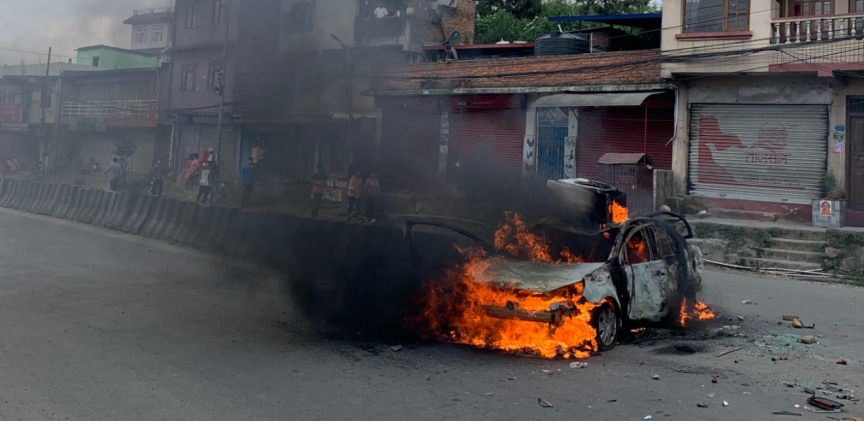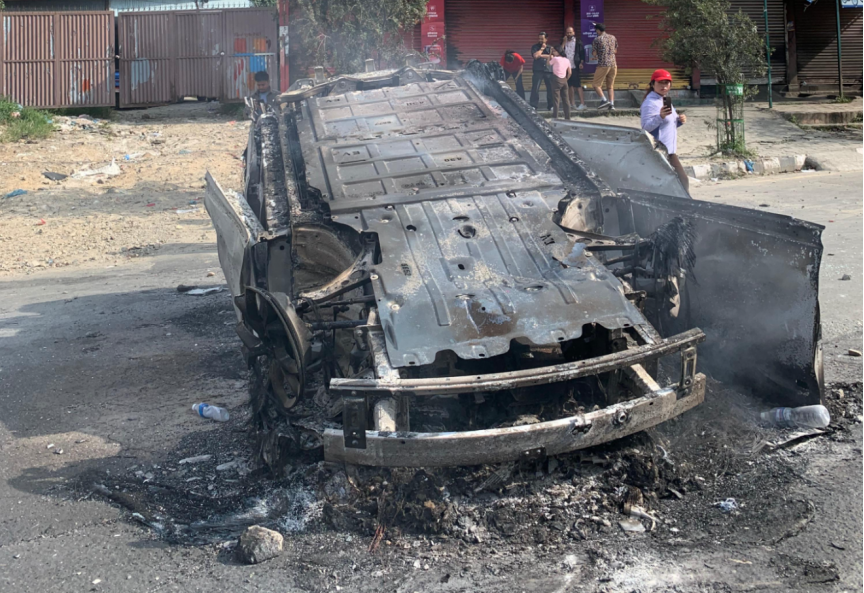EV Fire During Nepal’s Recent Gen-Z Protest: Understanding the Science and Risks
Najam Rain
September 21, 2025
While protests are a form of expression, such incidents bring attention to another crucial concern: vehicle fire safety. According to Gorkhapatra news, more than 3,500 vehicles were damaged and reduced to ashes during the protest, including both public and private sector vehicles.
Unlike petrol or diesel vehicles, EV fires are fundamentally different — not only in how they start but also in how long they burn.

How Does an Electric Vehicle Catch Fire?
Fires in EVs are usually the result of the battery pack (lithium-ion cells) being damaged. It might happen during a riot or protest when:
External damage – Stones, rods, or fire may physically injure the battery cells.
Thermal runaway – Defective lithium-ion cells are subject to rapid overheating.
Short circuit – When fire or impact melts the insulation, the uncontrolled flow of current causes ignition.

Once one cell catches fire, it spreads to the next, creating a chain reaction known as thermal runaway.
How Dangerous Does It Become?
An EV fire is much more dangerous than a fuel vehicle fire because:
It releases toxic gases like hydrogen fluoride.
Fire temperatures may exceed 1,000°C, capable of melting metal.
The fires are difficult to extinguish with water or foam. Firefighters normally require special cooling techniques.
Even hours after being put out, the battery might re-ignite.
In a word, once an EV battery catches fire, it is unpredictable and dangerous for anyone nearby.
How Long Does an EV Fire Last?
Unlike petrol fires that will go out once all the fuel is burnt, an EV battery fire might continue for hours. The fires on an EV typically range between two and three hours, depending on the size of the battery, although in some cases around the world, fire departments have fought fires for longer than 24 hours without complete extinguishment. Even after being put out, batteries remain at risk of bursting into flames days later unless brought down adequately. This renders burning out EVs during civil uprisings much more dangerous and longer-lasting compared to traditional autos.
When the vehicle catches fire, the driver or passenger should carry out the following steps:
Step 1: Get out of the car quickly and see the traffic police.
Step 2: Provided that one keeps him/herself safe, apply the following actions as and when the situation permits:
If it is on fire, spray with a carbon dioxide or dry powder fire extinguisher;
If it is on fire, attempt to extinguish the flames with a water torch at long distance;
In case you inhale thick smoke involuntarily, please transfer and seek medical attention promptly.
Step 3: Inform the car dealership so that you may receive other suggestions.
Note: If there is a fire caused by abnormal charging, be sure to turn off the charging power as soon as possible, and then carry out the next step of fire extinguishing.
The following tools can be used to extinguish a fire, depending on the fire level and the surrounding environment:

With Nepal moving toward cleaner transport, public safety has become very important. A recent incident showed that electric vehicles can also be damaged or set on fire, and once burning, they are much harder to control than normal vehicles. This makes it important for authorities, firefighters, and the public to know how to deal with EV fires. While EVs are the future of clean travel in Nepal, using them as protest targets creates serious fire risks that can last for hours and put many lives in danger. Instead of burning vehicles, our focus should be on fighting corruption and injustice in positive and responsible ways.
You may also like
EV
April 17, 2025
Building Nepal’s EV Ecosystem: The Role of Infrastructure, Training, and Policy Support
EV
April 30, 2025
Nepal’s Surge in Electric Vehicle Imports: A Rs 12.73 Billion Journey.
EV
July 11, 2025

